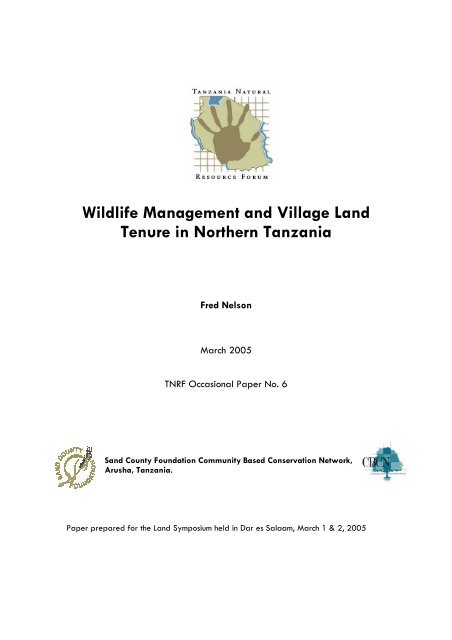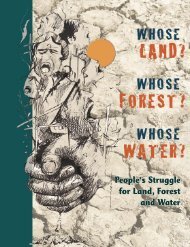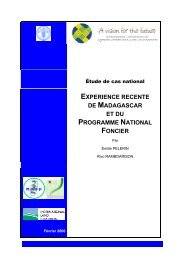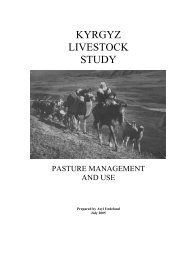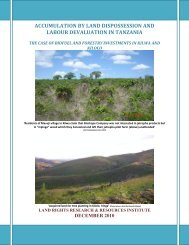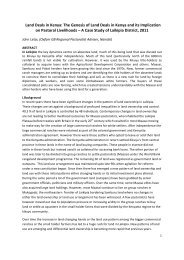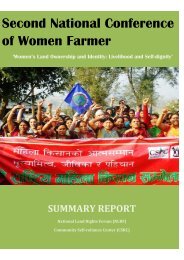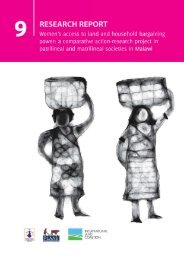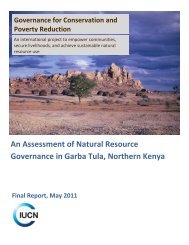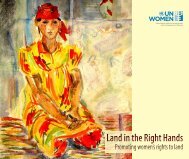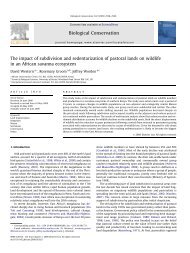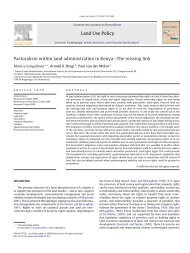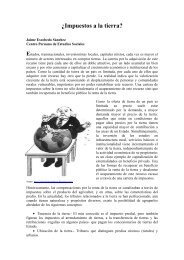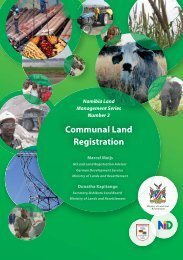Wildlife Management and Village Land Tenure in ... - Land Portal
Wildlife Management and Village Land Tenure in ... - Land Portal
Wildlife Management and Village Land Tenure in ... - Land Portal
Create successful ePaper yourself
Turn your PDF publications into a flip-book with our unique Google optimized e-Paper software.
<strong>Wildlife</strong> <strong>Management</strong> <strong>and</strong> <strong>Village</strong> L<strong>and</strong><br />
<strong>Tenure</strong> <strong>in</strong> Northern Tanzania<br />
Fred Nelson<br />
March 2005<br />
TNRF Occasional Paper No. 6<br />
S<strong>and</strong> County Foundation Community Based Conservation Network,<br />
Arusha, Tanzania.<br />
Paper prepared for the L<strong>and</strong> Symposium held <strong>in</strong> Dar es Salaam, March 1 & 2, 2005
Disclaimer: The op<strong>in</strong>ions <strong>and</strong> views conta<strong>in</strong>ed with<strong>in</strong> the TNRF Occasional Papers Series do<br />
not necessarily represent those of the Tanzania Natural Resource Forum expressed or<br />
implied. They are solely those of their respective authors.<br />
1
Introduction<br />
Northern Tanzania’s l<strong>and</strong>scape is characterized by extensive semi-arid rangel<strong>and</strong>s where<br />
rural communities, mostly pastoralists or agro-pastoralists, use large tracts of l<strong>and</strong>s <strong>and</strong><br />
widely distributed resources <strong>in</strong> a climatically unpredictable environment. Secur<strong>in</strong>g<br />
access to the l<strong>and</strong> base which such livelihoods depend on <strong>in</strong> these savannah rangel<strong>and</strong>s is<br />
critical for these people, <strong>and</strong> has been the central socioeconomic <strong>and</strong> political issue <strong>in</strong><br />
northern Tanzania dur<strong>in</strong>g much of the past twenty years.<br />
Northern Tanzania’s communities share their environment with some of the most<br />
substantial rema<strong>in</strong><strong>in</strong>g populations of wild animals rema<strong>in</strong><strong>in</strong>g <strong>in</strong> the world. This wildlife<br />
is the subject of long-st<strong>and</strong><strong>in</strong>g conservation efforts <strong>and</strong> is the basis of a tourism <strong>in</strong>dustry<br />
valued at around 10% of Tanzania’s national GDP (World Bank/MIGA 2002). The<br />
<strong>in</strong>teraction between wildlife management on the one h<strong>and</strong>, <strong>and</strong> rural l<strong>and</strong> tenure, on the<br />
other, is a complex one. On the one h<strong>and</strong>, much of the wildlife <strong>in</strong> northern Tanzania<br />
rema<strong>in</strong>s widely dispersed across the region’s rangel<strong>and</strong>s because of the traditional coexistence<br />
of pastoralist l<strong>and</strong> use practices with wildlife (Collet, 1987; Homewood <strong>and</strong><br />
Rodgers, 1991; Boone <strong>and</strong> Coughenour, 2001). But at the same time, the establishment<br />
of state protected areas for wildlife <strong>and</strong> tourism has been a major cause of local l<strong>and</strong> loss<br />
<strong>and</strong> alienation <strong>in</strong> northern Tanzania dur<strong>in</strong>g the past fifty years (Parkipuny, 1991;<br />
Neumann, 1998; Igoe <strong>and</strong> Brock<strong>in</strong>gton, 1999).<br />
Today the tensions between wildlife management <strong>and</strong> village l<strong>and</strong> tenure cont<strong>in</strong>ue, albeit<br />
with new nuances, legal issues, <strong>and</strong> contest<strong>in</strong>g parties over access to l<strong>and</strong>s <strong>and</strong> resources.<br />
The focus of local l<strong>and</strong> tenure contests has shifted from the core state protected areas- the<br />
National Parks <strong>and</strong> Game Reserves- which <strong>in</strong> most cases were removed from local<br />
control decades ago, to the village l<strong>and</strong>s themselves. The issue is no longer the black<strong>and</strong>-white<br />
one of evict<strong>in</strong>g local people <strong>and</strong> establish<strong>in</strong>g exclusive parks, but centers<br />
around numerous local contests over degrees of control of access <strong>and</strong> rights to l<strong>and</strong> <strong>and</strong><br />
wildlife.<br />
This paper explores <strong>and</strong> analyzes these contemporary contests over l<strong>and</strong> tenure <strong>in</strong><br />
northern Tanzania’s village l<strong>and</strong>s as they relate to wildlife management <strong>and</strong> l<strong>and</strong> policy<br />
<strong>and</strong> legislation. It details the nature of the contests <strong>and</strong> conflicts, <strong>in</strong>clud<strong>in</strong>g their legal<br />
aspects, <strong>and</strong> further seeks to diagnose the underly<strong>in</strong>g political economic reasons beh<strong>in</strong>d<br />
these endemic conflicts. It concludes by relat<strong>in</strong>g these underly<strong>in</strong>g issues to the broader<br />
macroeconomic environment <strong>and</strong> efforts to improve the security of local l<strong>and</strong> tenure <strong>in</strong><br />
the region for both livelihood <strong>and</strong> environmental concerns.<br />
Background: Rural L<strong>and</strong> <strong>Tenure</strong> <strong>and</strong> <strong>Wildlife</strong> <strong>Management</strong> <strong>in</strong> Northern Tanzania<br />
Interactions between wildlife management <strong>and</strong> local l<strong>and</strong> rights <strong>in</strong> northern Tanzania can<br />
be traced back to the colonial period. Initial wildlife laws <strong>and</strong> regulations passed by the<br />
German colonial regime <strong>in</strong> the 1890’s <strong>and</strong> early 1900’s focused primarily on restrict<strong>in</strong>g<br />
the use of wildlife (kill<strong>in</strong>g animals), <strong>and</strong> where reserves were set up with conservation<br />
purposes <strong>in</strong> m<strong>in</strong>d the rights of local people to live <strong>in</strong> <strong>and</strong> use them were reta<strong>in</strong>ed. It was<br />
2
not until the 1930’s under the British protectorate that wildlife management strategies <strong>in</strong><br />
Tanganyika began to emphasize sett<strong>in</strong>g aside areas solely for wildlife <strong>and</strong> where local<br />
people’s l<strong>and</strong> rights would have to be ext<strong>in</strong>guished <strong>in</strong> the <strong>in</strong>terest of conservation<br />
(Neumann, 1998). By the 1950’s this push to set aside exclusive protected areas free of<br />
human habitation had grown <strong>and</strong> debate centered on the management of the Serengeti<br />
National Park. In 1959 the debate was concluded with the gazettement of Serengeti<br />
National Park <strong>and</strong> removal of the resident communities there<strong>in</strong>, which provided the<br />
precedent for what National Parks <strong>in</strong> Tanzania would be henceforth: conservation areas<br />
without people liv<strong>in</strong>g <strong>in</strong> them (Neumann, 1998).<br />
In the years after <strong>in</strong>dependence wildlife conservation would cont<strong>in</strong>ue to receive strong<br />
back<strong>in</strong>g by the government <strong>and</strong> the approach would become more <strong>and</strong> more exclusive<br />
<strong>and</strong> restrictive <strong>in</strong> terms of local people’s l<strong>and</strong> <strong>and</strong> resource rights. The number of<br />
National Parks <strong>and</strong> Game Reserves rose from 10 to 32 from 1964 to 1994 (Swai, 1996,<br />
<strong>Wildlife</strong> Sector Review Task Force, 1995). Numerous additional evictions of people<br />
from l<strong>and</strong>s set aside as parks <strong>and</strong> reserves followed, rang<strong>in</strong>g from Tarangire <strong>in</strong> 1970 to<br />
Mkomazi <strong>in</strong> 1988 to Ikorongo <strong>and</strong> Grumeti Game Reserves <strong>in</strong> 1994. The impacts of<br />
wildlife conservation on local l<strong>and</strong> tenure, particularly <strong>in</strong> wildlife-rich northern<br />
Tanzania’s pastoralist areas, were obvious- people simply lost their l<strong>and</strong>s <strong>and</strong> important<br />
resources such as graz<strong>in</strong>g areas <strong>and</strong> water sources (Igoe <strong>and</strong> Brock<strong>in</strong>gton, 1999).<br />
While pastoralist communities lost access to numerous areas <strong>in</strong> the colonial <strong>and</strong> post<strong>in</strong>dependence<br />
periods, other more contemporary forces came to impact the l<strong>and</strong> tenure<br />
security of rural communities <strong>in</strong> northern Tanzania as well. The economic liberalization<br />
<strong>and</strong> structural adjustment reforms that began <strong>in</strong> the mid-1980’s led to widespread ‘l<strong>and</strong>grabb<strong>in</strong>g’<br />
<strong>in</strong> many of the agro-pastoralist rangel<strong>and</strong>s <strong>in</strong> the northern part of the country<br />
(Shivji, 1998). This was driven by the <strong>in</strong>crease <strong>in</strong> private <strong>in</strong>vestments com<strong>in</strong>g <strong>in</strong>to the<br />
country at this time <strong>and</strong> the attendant focus on allocat<strong>in</strong>g l<strong>and</strong> for such <strong>in</strong>vestments, set<br />
aga<strong>in</strong>st the background of generally weak customary l<strong>and</strong> tenure go<strong>in</strong>g back to the early<br />
colonial era (URT, 1994, Shivji, 1998). An additional factor was <strong>in</strong>creased dem<strong>and</strong> for<br />
l<strong>and</strong> result<strong>in</strong>g from overpopulation <strong>and</strong> economic pressures <strong>in</strong> the highl<strong>and</strong> areas, lead<strong>in</strong>g<br />
to migration from highl<strong>and</strong>s (e.g. Mount Meru) to semi-arid areas (e.g. Simanjiro<br />
District). The migration of farmers to pastoralist areas, coupled with population<br />
<strong>in</strong>creases <strong>and</strong> l<strong>and</strong> pressures among pastoralist communities, led to <strong>in</strong>creas<strong>in</strong>g conflicts<br />
between communal <strong>and</strong> <strong>in</strong>dividual tenure systems at both regional <strong>and</strong> local scales.<br />
Transfer of l<strong>and</strong> from local community uses to outsiders- both large scale private<br />
<strong>in</strong>vestors <strong>and</strong> small scale immigrant farmers- was facilitated by village government<br />
leaders operat<strong>in</strong>g with low degrees of accountability <strong>and</strong> with little apparent<br />
underst<strong>and</strong><strong>in</strong>g of the implications of sell<strong>in</strong>g communal l<strong>and</strong>s (Igoe <strong>and</strong> Brock<strong>in</strong>gton,<br />
1999).<br />
As a result of these factors, by the l<strong>and</strong> tenure reform period of the mid-1990’s, the<br />
situation <strong>in</strong> terms of local l<strong>and</strong> tenure security <strong>in</strong> northern Tanzania can broadly be<br />
summarized as follows:<br />
Community l<strong>and</strong>s had been greatly reduced dur<strong>in</strong>g the previous century due to<br />
alienation of rangel<strong>and</strong>s for wildlife protected areas, <strong>and</strong> expansion of parks <strong>and</strong><br />
3
oundary disputes between villagers <strong>and</strong> protected area managers perpetuated this<br />
process of alienation <strong>and</strong> attrition;<br />
<strong>Village</strong> l<strong>and</strong>s were under pressure from alienation for outside <strong>in</strong>vestors result<strong>in</strong>g<br />
from both state allocations <strong>and</strong> local sales often carried out <strong>in</strong> a corrupt or nontransparent<br />
manner.<br />
The conflicts between local l<strong>and</strong> tenure security <strong>and</strong> wildlife management received some<br />
attention <strong>in</strong> the L<strong>and</strong> Commission report of 1992 (URT, 1994). Problems with l<strong>and</strong><br />
tenure security <strong>in</strong> northern Tanzania <strong>in</strong>fluenced components of the National L<strong>and</strong> Policy<br />
(1995, 1997) <strong>and</strong> the L<strong>and</strong> Act <strong>and</strong> <strong>Village</strong> L<strong>and</strong> Act. General objectives of the policy a<br />
<strong>and</strong> the law <strong>in</strong>clude better secur<strong>in</strong>g customary rights <strong>and</strong> provid<strong>in</strong>g greater local security.<br />
Contemporary Interactions between <strong>Wildlife</strong> <strong>Management</strong> <strong>and</strong> L<strong>and</strong> <strong>Tenure</strong> on<br />
<strong>Village</strong> L<strong>and</strong>s <strong>in</strong> Northern Tanzania<br />
One of the basic aspects of the framework for l<strong>and</strong> tenure <strong>and</strong> management <strong>in</strong> Tanzania<br />
follow<strong>in</strong>g the passage of the new l<strong>and</strong> laws <strong>in</strong> 1999 is the division of all the l<strong>and</strong>s <strong>in</strong> the<br />
country <strong>in</strong>to three categories: general, reserved, <strong>and</strong> village l<strong>and</strong>. Reserved l<strong>and</strong>s are<br />
def<strong>in</strong>ed by the L<strong>and</strong> Act as areas established under sectoral legislation such as the<br />
National Parks Ord<strong>in</strong>ance, Mar<strong>in</strong>e Parks <strong>and</strong> Reserves Act, <strong>and</strong> the <strong>Wildlife</strong><br />
Conservation Act of 1974 which cont<strong>in</strong>ues to be the country’s pr<strong>in</strong>ciple wildlife<br />
legislation today. The <strong>Wildlife</strong> Conservation Act (WCA) conta<strong>in</strong>s provisions for<br />
establish<strong>in</strong>g three types of protected areas: Game Reserves, Game Controlled Areas, <strong>and</strong><br />
Partial Game Reserves 1 . In Game Reserves human entry <strong>and</strong> habitation is forbidden<br />
without express permission of the Director of <strong>Wildlife</strong>; these areas function much as<br />
National Parks <strong>in</strong> that they are exclusive protected areas managed for wildlife.<br />
Game Controlled Areas (GCA’s) are a different type of protected area <strong>and</strong> one which is<br />
surrounded by considerable confusion <strong>and</strong> ambiguity with regards to its management.<br />
The formation of GCA’s orig<strong>in</strong>ated <strong>in</strong> the pre-<strong>in</strong>dependence era, when certa<strong>in</strong> stretches<br />
of country were designated as ‘controlled areas’ with respect to wildlife hunt<strong>in</strong>g. This<br />
meant that wildlife utilization <strong>in</strong> such areas required a license from the government; at<br />
this time wildlife uses outside of controlled or reserved areas was not regulated except for<br />
certa<strong>in</strong> species.<br />
Provisions for creat<strong>in</strong>g <strong>and</strong> manag<strong>in</strong>g GCA’s were conta<strong>in</strong>ed <strong>in</strong> the WCA which repealed<br />
the colonial wildlife legislation. GCA’s as def<strong>in</strong>ed by the WCA rema<strong>in</strong>ed, however, as<br />
protected areas where only the utilization of wildlife was restricted <strong>and</strong> regulated; human<br />
use <strong>and</strong> settlement, cutt<strong>in</strong>g of vegetation, <strong>and</strong> graz<strong>in</strong>g of cattle were not regulated <strong>in</strong> any<br />
way <strong>in</strong> these areas. S<strong>in</strong>ce the WCA generally provides that wildlife use anywhere <strong>in</strong> the<br />
country, except for species classified as verm<strong>in</strong> or not listed on schedules to the Act,<br />
requires a government license, wildlife <strong>in</strong> GCA’s does not actually receive any more<br />
protection than wildlife <strong>in</strong> nom<strong>in</strong>ally unprotected areas. It is for this reason that the<br />
1 Partial Game Reserves have not been created under the WCA so this category of protected area is<br />
irrelevant for purposes of this discussion.<br />
4
GCA’s have themselves been referred to as ‘unprotected’ areas. The <strong>Wildlife</strong> Sector<br />
Review Task Force (1995) convened by the M<strong>in</strong>istry <strong>in</strong> the early 1990’s concluded that<br />
GCA’s were “totally <strong>in</strong>effective” as <strong>in</strong> terms of conserv<strong>in</strong>g wildlife.<br />
GCA’s have thus been, both <strong>in</strong>itially <strong>in</strong> the colonial period <strong>and</strong> follow<strong>in</strong>g passage of the<br />
WCA, areas where the l<strong>and</strong> rights of resident people are not ext<strong>in</strong>guished or<br />
circumscribed. Thus people have generally lived <strong>in</strong> them <strong>and</strong> exercised their customary<br />
l<strong>and</strong> rights; only the right to utilize wildlife was restricted (as it was everywhere else <strong>in</strong><br />
the country after 1974). This dual <strong>and</strong> overlapp<strong>in</strong>g use of these areas as a nom<strong>in</strong>ally<br />
protected area under the wildlife legislation, on the one h<strong>and</strong>, <strong>and</strong> local community l<strong>and</strong>s,<br />
on the other, was touched on by the L<strong>and</strong> Commission <strong>in</strong> their f<strong>in</strong>al report. The<br />
Commission categorized GCA’s, cover<strong>in</strong>g almost 10% of the country, among the many<br />
l<strong>and</strong>s <strong>in</strong> the country where confusion existed as to the status of l<strong>and</strong> tenure (URT, 1994).<br />
As can be seen <strong>in</strong> Figure 1 below, a concentration of Tanzania’s GCA’s exist <strong>in</strong> the<br />
wildlife-rich north-central part of the country, largely <strong>in</strong> pastoralist areas.<br />
The National L<strong>and</strong> Policy (MLHSD, 1997) recognized the conflict created by hav<strong>in</strong>g<br />
GCA’s <strong>and</strong> community l<strong>and</strong>s exist<strong>in</strong>g <strong>in</strong> the same places. The Policy recommended that<br />
GCA’s should serve as ‘buffer zones’ without agriculture or settlements where the<br />
GCA’s were adjacent to important wildlife areas, <strong>and</strong> that they should be upgraded to<br />
Game Reserves or allocated for ‘resettlement’ <strong>in</strong> areas not adjacent to protected areas. 2<br />
It is important to note that the Policy, by stat<strong>in</strong>g that GCA’s will either be upgraded to<br />
reserves or allocated for resettlement, is implicitly <strong>in</strong>terpret<strong>in</strong>g GCA’s as areas which are<br />
not settled <strong>and</strong> where customary l<strong>and</strong> rights were not established. As stated above, this is<br />
not correct <strong>and</strong> customary l<strong>and</strong> rights have always been established <strong>and</strong> never<br />
ext<strong>in</strong>guished <strong>in</strong> GCA’s; allocat<strong>in</strong>g such areas for resettlement is therefore not a realistic<br />
option <strong>and</strong> a mis<strong>in</strong>terpretation of the situation on the ground.<br />
The reality at the local level is that many GCA’s overlap entirely with demarcated village<br />
l<strong>and</strong>s. Figure 2a <strong>and</strong> 2b show the overlap of GCA’s <strong>and</strong> village l<strong>and</strong>s <strong>in</strong> Ngorongoro<br />
District (Loliondo <strong>and</strong> Sale Divisions) <strong>and</strong> the northeast portion of Monduli District.<br />
Indeed, about 95% of Monduli District’s total l<strong>and</strong> area is conta<strong>in</strong>ed <strong>in</strong> GCA’s, while at<br />
the same time all of the district is divided <strong>in</strong>to demarcated villages, many of which have<br />
been surveyed <strong>and</strong> are await<strong>in</strong>g receipt of Certificate of <strong>Village</strong> L<strong>and</strong>s. In Loliondo<br />
Division some of the villages with<strong>in</strong> Loliondo GCA (Figure 2b) received title deeds to<br />
their l<strong>and</strong>s <strong>in</strong> the early 1990’s dur<strong>in</strong>g the national push for village titl<strong>in</strong>g.<br />
There are both legal <strong>and</strong> practical implications to this situation of overlapp<strong>in</strong>g l<strong>and</strong><br />
categories. Adm<strong>in</strong>istratively, the ma<strong>in</strong> use of wildlife <strong>in</strong> GCA’s is as tourist hunt<strong>in</strong>g<br />
concessions granted by the <strong>Wildlife</strong> Division of the M<strong>in</strong>istry of Natural Resources <strong>and</strong><br />
Tourism (Leader-Williams et al., 1996; Baldus <strong>and</strong> Cauldwell, 2004).<br />
2 Section 7.4.1<br />
5
Western Tanzania 6 Msima GCA 12 Mlele South GCA 18 Wembere OA North<br />
1 Makere Forest 7 Ugunda GCA 13 Lake Rukwa GCA 19 Wembere OA Central<br />
2 Uv<strong>in</strong>za OA 8 Inyonga West GCA 14 Piti West OA 20 Wembere OA South<br />
3 Gombe GCA 9 Inyonga East GCA 15 Inyonga East 21 Itulu Forest East<br />
4 Luganzo GCA 10 Rungwa River GCA 16 Chunya OA 22 S<strong>in</strong>gida OA<br />
5 Ugalla OA 11 Mlele North GCA 17 Utengule Swamp OA 23 Manyoni OA<br />
Masail<strong>and</strong><br />
24 Maswa OA 31 Mto wa Mbu GCA 38 Lolkisale 45 Ruvu Masai<br />
25 Nyichoka OA 32 Monduli Juu 39 Simanjiro West 46 Kitwai North<br />
26 Sibora OA 33 Maswa Makao 40 Simanjiro Kitangare 47 Kitwai Central<br />
27 Loliondo GCA 34 Yaeda Ch<strong>in</strong>i OA 41 Simanjiro Naberra 48 Kitwai South<br />
28 Loliondo South GCA 35 Lake Balangida 42 Simanjiro East 49 Masai OA<br />
29 Lake Natron GCA 36 Babati OA 43 Sanya Lelatema 50 Mkungunero<br />
30 Longido GCA 37 Burunge 44 Ruvu Same 51 Kondoa OA<br />
Selous / SE Coastal<br />
52 Gonabis / Jukumu WMA 56 Kilombero GCA South 60 Tunduru Forest 63 Mahenge OA South<br />
53 Liwale OA North 57 Namtumbo WMA 61 Tapika OA<br />
54 Liwale OA South 58 Tunduru WMA<br />
55 Kilombero GCA North 59 Sasawara Forest<br />
6<br />
62 Kilwa OA North, Central<br />
& South<br />
Figure 1: National distribution of Game Controlled Areas <strong>and</strong> other protected areas <strong>and</strong><br />
hunt<strong>in</strong>g block concessions. Source: Baldus <strong>and</strong> Cauldwell, 2004.
Ngoswak<br />
Ma irowa<br />
Les<strong>in</strong> gita<br />
Kes eria n<br />
Mfe re ji<br />
S<strong>in</strong>onik<br />
Engikaret<br />
Kim oko uwa<br />
Long ido<br />
Nam an ga<br />
7<br />
KENYA<br />
S<strong>in</strong>ya<br />
Ngereya ni T<strong>in</strong>ga-<br />
T<strong>in</strong>ga<br />
Elerai<br />
Ol M olog<br />
W<br />
N<br />
S<br />
E<br />
10 0 10 20 Kilo m eters<br />
Lerang wa Irkaswa<br />
Mt. Kilim a njaro<br />
Ma<strong>in</strong> Roa d<br />
Lon gido G CA<br />
Lake Natron G CA<br />
Op en A re a<br />
Figure 2a: Overlap of GCA’s <strong>and</strong> village l<strong>and</strong>s <strong>in</strong> northeast Monduli District.<br />
Kam wan ga<br />
Figure 2b: Overlap of GCA’s <strong>and</strong> village l<strong>and</strong>s <strong>in</strong> Loliondo <strong>and</strong> Sale Divisions,<br />
Ngorongoro District. GCA demarcated by dotted l<strong>in</strong>e, solid l<strong>in</strong>es are village boundaries.
Allocation of these areas to hunt<strong>in</strong>g companies has not taken <strong>in</strong>to account the l<strong>and</strong> rights<br />
of the communities resident <strong>in</strong> the GCA’s. The WCA has a provision that hunt<strong>in</strong>g carried<br />
out on private l<strong>and</strong>s requires the consent of the l<strong>and</strong>owner 3 , <strong>and</strong> titled or certified village<br />
l<strong>and</strong>s qualify accord<strong>in</strong>g to the WCA def<strong>in</strong>ition of private l<strong>and</strong>s, but this consent has never<br />
been sought when allocat<strong>in</strong>g hunt<strong>in</strong>g concessions <strong>and</strong> <strong>in</strong> general local communities have<br />
no role <strong>in</strong> the block allocation process (Majamba, 2001). The result is that tourist hunt<strong>in</strong>g<br />
is conducted extensively on community l<strong>and</strong>s without the permission or <strong>in</strong>volvement of<br />
the l<strong>and</strong>holder. Some conflicts <strong>in</strong>evitably occur as a result of outsiders be<strong>in</strong>g granted<br />
access to village l<strong>and</strong>s without the participation of the people liv<strong>in</strong>g there. Hunt<strong>in</strong>g<br />
activities may conflict with livestock graz<strong>in</strong>g or forest products collection or other local<br />
economic activities.<br />
A more widespread conflict has erupted dur<strong>in</strong>g the past five years between the tourist<br />
hunt<strong>in</strong>g concessions on village l<strong>and</strong>s <strong>and</strong> non-consumptive tourism activities occurr<strong>in</strong>g <strong>in</strong><br />
the same areas (Masara, 2000; Nelson, 2003). These tourism activities have developed<br />
on village l<strong>and</strong>s as agreements between private companies <strong>and</strong> the local village<br />
governments whereby companies are granted access to the area <strong>and</strong> the villages receive<br />
set payments from the companies. In contrast to the centrally managed hunt<strong>in</strong>g<br />
concessions, these arrangements are developed locally based on the villages’ status under<br />
the Local Government Act of 1982 as corporate bodies <strong>and</strong> their rights under the <strong>Village</strong><br />
L<strong>and</strong> Act to manage l<strong>and</strong> on behalf of the community (Nshala, 2002). Some<br />
communities have been able to earn up to $50,000 annually from these tourism<br />
agreements, provid<strong>in</strong>g an important source of economic diversification <strong>in</strong> northern<br />
Tanzanian community rangel<strong>and</strong>s (Nelson, 2004). But because these tourism activities<br />
conflict with the pre-exist<strong>in</strong>g hunt<strong>in</strong>g concessions, both hunt<strong>in</strong>g operators <strong>and</strong> central<br />
government have moved to preclude these agreements from cont<strong>in</strong>u<strong>in</strong>g <strong>in</strong> these areas<br />
(Masara, 2000; Jones, 2001; Nelson, 2003). Regulations govern<strong>in</strong>g tourist hunt<strong>in</strong>g were<br />
issued <strong>in</strong> 2000 which specifically seek to prohibit tourism from be<strong>in</strong>g carried out <strong>in</strong> any<br />
hunt<strong>in</strong>g blocks, <strong>in</strong>clud<strong>in</strong>g those on village l<strong>and</strong>s, without the express permission of the<br />
Director of <strong>Wildlife</strong> (MNRT, 2000; Nshala, 2002). At least one operator has been<br />
charged with violat<strong>in</strong>g these regulations <strong>and</strong> numerous villages <strong>in</strong> northern Tanzania<br />
st<strong>and</strong> to lose substantial sources of <strong>in</strong>come from tourism should they be fully enforced.<br />
The overlap of GCA’s <strong>and</strong> village l<strong>and</strong>s is consequently a widespread source of conflict<br />
between local community <strong>in</strong>terests <strong>and</strong> external government <strong>and</strong> private sector <strong>in</strong>terests<br />
<strong>in</strong> access<strong>in</strong>g these areas to utilize wildlife <strong>and</strong> l<strong>and</strong> <strong>in</strong> hunt<strong>in</strong>g concessions. These<br />
conflicts thus represent a contest over l<strong>and</strong> rights <strong>and</strong> access <strong>in</strong> village l<strong>and</strong>s between the<br />
various parties <strong>in</strong>volved.<br />
It was noted that the L<strong>and</strong> Commission identified the confusion engendered by the<br />
overlap of GCA’s’ with areas held under customary rights of occupancy, as did the<br />
National L<strong>and</strong> Policy albeit with a confused underst<strong>and</strong><strong>in</strong>g of the local realities of these<br />
overlaps. The <strong>Wildlife</strong> Policy of Tanzania, released after the L<strong>and</strong> Policy <strong>in</strong> March,<br />
3 The Director of <strong>Wildlife</strong> can, <strong>in</strong> the “public <strong>in</strong>terest”, override this consent clause. “Public <strong>in</strong>terest” is<br />
however not def<strong>in</strong>ed by the WCA.<br />
8
1998, generally aims to promote the transfer of greater control over l<strong>and</strong> <strong>and</strong> wildlife <strong>in</strong><br />
GCA’s <strong>and</strong> other unprotected areas to the local communities liv<strong>in</strong>g there <strong>in</strong> order to<br />
promote ‘community-based conservation’ (MNRT, 1998).<br />
Subsequent legislative efforts, however, have not functioned to resolve the problems of<br />
GCA’s overlapp<strong>in</strong>g with community l<strong>and</strong>s but have <strong>in</strong>stead entrenched them. As was<br />
noted, the L<strong>and</strong> Act identifies reserved l<strong>and</strong>s as those areas created under the WCA,<br />
<strong>in</strong>clud<strong>in</strong>g GCA’s. A read<strong>in</strong>g of Part II, Section 5.6, of the L<strong>and</strong> Act clearly leads one to<br />
the conclusion that GCA’s are reserved l<strong>and</strong>s under the jurisdiction of the <strong>Wildlife</strong><br />
Division. Yet the L<strong>and</strong> Act also def<strong>in</strong>es village l<strong>and</strong>s accord<strong>in</strong>g to the def<strong>in</strong>itions laid out<br />
<strong>in</strong> detail <strong>in</strong> the <strong>Village</strong> L<strong>and</strong> Act. Clearly, given the customary use <strong>and</strong> occupancy of<br />
most GCA’s, <strong>in</strong>clud<strong>in</strong>g all of the ones on pastoralist l<strong>and</strong>s <strong>in</strong> northern Tanzania, these<br />
same areas are also village l<strong>and</strong>s. It is obviously <strong>in</strong>imical to the aims of both the National<br />
L<strong>and</strong> Policy <strong>and</strong> the L<strong>and</strong> Act to improve the security of customary l<strong>and</strong> rights, to have<br />
10% of the country, <strong>in</strong>clud<strong>in</strong>g entire districts such as Monduli, def<strong>in</strong>ed <strong>in</strong> different ways<br />
as both reserved <strong>and</strong> village l<strong>and</strong>s. It is this legal situation that facilitates the on-go<strong>in</strong>g<br />
conflicts on the ground, whereby both the villages <strong>and</strong> the <strong>Wildlife</strong> Division are able to<br />
<strong>in</strong>terpret the laws as giv<strong>in</strong>g them control <strong>and</strong> jurisdiction over these areas. Legal<br />
confusion begets local chaos <strong>and</strong> <strong>in</strong>security among both rural communities as well as<br />
<strong>in</strong>vestors on both sides of the tourism-hunt<strong>in</strong>g conflict. None of the parties are able to<br />
clearly determ<strong>in</strong>e their rights because their rights are contradictorily def<strong>in</strong>ed <strong>in</strong> the law.<br />
Underst<strong>and</strong><strong>in</strong>g Entrenched Conflicts: Persistence <strong>and</strong> Resolution<br />
The conflicts over wildlife management <strong>and</strong> village l<strong>and</strong> tenure that result from the<br />
overlap of GCA’s <strong>and</strong> village l<strong>and</strong>s as entrenched by the L<strong>and</strong> Act is a widespread<br />
problem for local tenure security <strong>in</strong> most of rural northern Tanzania. This is <strong>in</strong> <strong>and</strong> of<br />
itself a significant problem, as it works to underm<strong>in</strong>e the stability of rural economies<br />
<strong>in</strong>clud<strong>in</strong>g many livestock producers, <strong>and</strong> leads to conflicts that can result <strong>in</strong> human rights<br />
abuses. The situation also creates a poor environment for private <strong>in</strong>vestment <strong>in</strong> the<br />
wildlife <strong>and</strong> tourism sectors <strong>in</strong> some of the best l<strong>and</strong>s for such <strong>in</strong>vestments anywhere <strong>in</strong><br />
Tanzania.<br />
It is important to emphasize that the pr<strong>in</strong>ciple cause of these conflicts <strong>and</strong> the cascad<strong>in</strong>g<br />
economic problems that they create is not a lack of underst<strong>and</strong><strong>in</strong>g of the nature of the<br />
conflicts. As I have noted, the L<strong>and</strong> Commission identified the GCA-customary l<strong>and</strong><br />
rights overlap as a source of confusion, as did the subsequent L<strong>and</strong> Policy.<br />
Yet the L<strong>and</strong> Act, rather than remov<strong>in</strong>g the statutory confusion surround<strong>in</strong>g these areas,<br />
entrenched them by def<strong>in</strong><strong>in</strong>g GCA’s as reserved l<strong>and</strong>s <strong>and</strong> the same areas as village<br />
l<strong>and</strong>s, which now overlap entirely <strong>in</strong> large tracts of the country. A draft <strong>Wildlife</strong> Act to<br />
better implement the <strong>Wildlife</strong> Policy has been the subject of extensive consultations<br />
nationwide dur<strong>in</strong>g the past several years <strong>and</strong> is reportedly planned for tabl<strong>in</strong>g <strong>in</strong><br />
Parliament dur<strong>in</strong>g 2005. Like the l<strong>and</strong> legislation, this bill does not resolve the GCAvillage<br />
l<strong>and</strong> conflicts but if passed would serve to entrench them further. The bill does<br />
9
not change any of the provisions for establish<strong>in</strong>g <strong>and</strong> manag<strong>in</strong>g GCA’s from those <strong>in</strong> the<br />
1974 WCA. 4<br />
Thus the conflicts between GCA’s <strong>and</strong> village l<strong>and</strong>s are fundamentally tied to problems<br />
of implement<strong>in</strong>g policy directives <strong>and</strong> a notable divergence between sectoral policies <strong>and</strong><br />
the laws which are drafted to give them force; one sees this divergence <strong>in</strong> both the l<strong>and</strong><br />
<strong>and</strong> the wildlife sectors. What then, are the underly<strong>in</strong>g reasons for this divergence <strong>and</strong><br />
the conflicts that ensue from such <strong>in</strong>stitutional confusion?<br />
The conflict<strong>in</strong>g provisions <strong>in</strong> the l<strong>and</strong> legislation which result <strong>in</strong> the reserved-village l<strong>and</strong><br />
overlap <strong>in</strong> GCA’s can be looked at as the state want<strong>in</strong>g to have its cake <strong>and</strong> eat it too. On<br />
the one h<strong>and</strong>, the L<strong>and</strong> Commission report <strong>and</strong> the national l<strong>and</strong> reform campaign that<br />
ensued focused unprecedented attention on the <strong>in</strong>security of customary l<strong>and</strong> rights<br />
(Shivji, 1998). The l<strong>and</strong> policy <strong>and</strong> legislation, while not tak<strong>in</strong>g all the Commission’s<br />
recommendations on board, does respond to some of these concerns, for example by<br />
mak<strong>in</strong>g granted <strong>and</strong> customary rights legally equivalent. Provid<strong>in</strong>g more streaml<strong>in</strong>ed<br />
provisions for the demarcation <strong>and</strong> def<strong>in</strong>ition of village l<strong>and</strong>s accord<strong>in</strong>g to traditional use<br />
<strong>and</strong> occupation is further supportive of popular concerns over tenure security.<br />
But on the other h<strong>and</strong>, there was a strong imperative <strong>in</strong> the draft<strong>in</strong>g of the l<strong>and</strong> laws to<br />
reta<strong>in</strong> a great deal of discretionary power with<strong>in</strong> the executive branch, a dynamic which<br />
Sundet (1997) has described <strong>in</strong> detail. Ma<strong>in</strong>ta<strong>in</strong><strong>in</strong>g central jurisdiction <strong>in</strong> the GCA’s as<br />
reserved l<strong>and</strong>s through the wildlife authorities serves to legitimize central use <strong>and</strong><br />
allocation of the resources- l<strong>and</strong> <strong>and</strong> wildlife- found at the local level <strong>in</strong> these areas. This<br />
ma<strong>in</strong>ta<strong>in</strong>s central control over economic activities <strong>and</strong> <strong>in</strong>vestments, albeit often at the<br />
expense of local opportunities. One can also consider the <strong>in</strong>creas<strong>in</strong>g conflicts over the<br />
GCA’s as an extension of the frontiers of contested resource uses <strong>and</strong> rights from the core<br />
protected areas to the rural l<strong>and</strong>scape <strong>in</strong> general. Whereas the contests of the 1950’s were<br />
whether or not to evict communities from areas that would be created as National Parks,<br />
today’s conflicts center not on the parks, but on the village l<strong>and</strong>s that the communities<br />
rema<strong>in</strong> <strong>in</strong> possession of. The issue now is not whether communities may rega<strong>in</strong> what<br />
they have lost to conservation uses, but whether they will be able to exercise control over<br />
what l<strong>and</strong>s they still hold rights to. The contemporary GCA conflicts can therefore be<br />
looked at as a significant expansion of central control over economic resources <strong>in</strong>to areas<br />
previously managed (accord<strong>in</strong>g to both customary law <strong>and</strong> contemporary local<br />
government <strong>and</strong> l<strong>and</strong> laws) at the local level. It is notable that such central expansion<br />
st<strong>and</strong>s <strong>in</strong> marked contrast to the decentraliz<strong>in</strong>g <strong>and</strong> liberaliz<strong>in</strong>g rhetoric that surrounds<br />
many of the contemporary socioeconomic plans <strong>and</strong> strategies <strong>in</strong> Tanzania.<br />
Beyond the provisions that ma<strong>in</strong>ta<strong>in</strong> central authority over valuable resources as seen <strong>in</strong><br />
the l<strong>and</strong> legislation, another explanation of the conflict<strong>in</strong>g provisions with<strong>in</strong> that<br />
legislation relates more broadly to the value of laws which are confus<strong>in</strong>g to certa<strong>in</strong> vested<br />
4 The draft act <strong>in</strong> general does not appear to be <strong>in</strong> conformity <strong>in</strong> its pr<strong>in</strong>ciples or <strong>in</strong> its details with the<br />
wildlife policy, <strong>and</strong> reflects a much more centralized framework for wildlife management <strong>in</strong>clud<strong>in</strong>g further<br />
expansion of protected areas <strong>and</strong> regulatory powers of the government, than is recommended by the policy<br />
(see PINGOs Forum, 2004).<br />
10
<strong>in</strong>terests. By this I mean that one can theorize, based on exist<strong>in</strong>g political economy<br />
analysis (e.g. Chabol <strong>and</strong> Daloz, 1999), that confusion such as seen <strong>in</strong> the l<strong>and</strong> legislation<br />
with respect to GCA’s <strong>and</strong> village l<strong>and</strong>s is not an accident or a mistake, but serves certa<strong>in</strong><br />
purposes. More specifically, legal confusion creates chaos on the ground as different<br />
parties struggle to secure their rights <strong>and</strong> to access resources, <strong>and</strong> this chaos creates<br />
numerous opportunities for rent-seek<strong>in</strong>g with<strong>in</strong> the bureaucracy. Legal clarity, by<br />
contrast, reduces such chaos <strong>and</strong> rent-seek<strong>in</strong>g opportunities, <strong>and</strong> is therefore <strong>in</strong>imical to<br />
many vested <strong>in</strong>terests with<strong>in</strong> the <strong>in</strong>stitutions responsible for draft<strong>in</strong>g <strong>and</strong> implement<strong>in</strong>g<br />
laws. It is important to consider the possibility that this is one of the factors beh<strong>in</strong>d the<br />
problems that are exhibited by the conflicts <strong>in</strong> the l<strong>and</strong> laws, <strong>and</strong> that this also is<br />
emblematic of broader political economy dynamics with<strong>in</strong> Tanzania today.<br />
Conclusion<br />
This paper has overviewed some of the historical <strong>in</strong>teractions between wildlife<br />
management <strong>and</strong> local l<strong>and</strong> rights <strong>in</strong> Tanzania, <strong>and</strong> the tensions between those two<br />
elements that have existed for many years <strong>in</strong> the country go<strong>in</strong>g back to the colonial<br />
period. These tensions cont<strong>in</strong>ue <strong>in</strong>to the present, not only through cont<strong>in</strong>u<strong>in</strong>g evictions of<br />
local people for the establishment of state protected areas, but have been extended out<br />
<strong>in</strong>to the rural l<strong>and</strong>scape more broadly through wide-rang<strong>in</strong>g conflicts over village l<strong>and</strong><br />
tenure <strong>and</strong> overlapp<strong>in</strong>g wildlife areas. Specifically, the overlap of Game Controlled<br />
Areas <strong>and</strong> village l<strong>and</strong>s is the most prevalent l<strong>and</strong> tenure conflict at present <strong>in</strong> most of<br />
north-central Tanzania, <strong>and</strong> it is a conflict which has escalated considerably <strong>in</strong> the past<br />
five years. The cause of these conflicts is a general contest between central authorities<br />
<strong>and</strong> rural villages to control access to village l<strong>and</strong>s/GCA’s. <strong>Village</strong>s seek to use these<br />
areas for livestock graz<strong>in</strong>g <strong>and</strong> other livelihood activities <strong>in</strong>clud<strong>in</strong>g relatively new<br />
commercial tourism jo<strong>in</strong>t ventures, whereby central government leases these same l<strong>and</strong>s<br />
out as hunt<strong>in</strong>g concessions. The result of these conflicts is l<strong>and</strong> tenure <strong>in</strong>security,<br />
conflicts among different private <strong>in</strong>vestors, reduced <strong>in</strong>centives for wildlife conservation<br />
at the village level, <strong>and</strong> loss of revenue to rural villages.<br />
These conflicts do not arise from a failure of policies to address them; rather they stem<br />
from the failure of laws to adequately address key issues raised by policies. By contrast,<br />
exist<strong>in</strong>g laws <strong>and</strong> <strong>in</strong> particular the L<strong>and</strong> Act entrench these conflicts through the<br />
propagation of directly contradictory provisions. These provisions may serve two ma<strong>in</strong><br />
political economic purposes. First, to enable cont<strong>in</strong>ued central control over valuable<br />
economic resources ly<strong>in</strong>g on village l<strong>and</strong>s. And second, to create legal confusion which<br />
facilitates rent-seek<strong>in</strong>g opportunities <strong>and</strong> limits the enforcement of local rights based on<br />
legal clarity.<br />
Those seek<strong>in</strong>g to improve the l<strong>and</strong> tenure framework <strong>in</strong> Tanzania for economic, social,<br />
<strong>and</strong> environmental ends need to consider not only the proximate problems with the l<strong>and</strong><br />
legislation but these underly<strong>in</strong>g political economic forces that create such conflicts.<br />
Conflicts are not necessarily a by-product of errors or omissions <strong>in</strong> the law but a function<br />
of the contest<strong>in</strong>g political forces that <strong>in</strong>fluence the creation of laws, <strong>and</strong> of vested<br />
<strong>in</strong>terests that benefit from confusion <strong>and</strong> ambiguity <strong>in</strong> the allocation of l<strong>and</strong> <strong>and</strong> resource<br />
11
ights. L<strong>and</strong> is the most important resource <strong>in</strong> the country, <strong>and</strong> it is therefore the locus of<br />
many political economic struggles that apply more broadly to the national<br />
macroeconomic structures <strong>and</strong> dynamics. It is important to use experiences with l<strong>and</strong><br />
rights <strong>and</strong> tenure to <strong>in</strong>form an underst<strong>and</strong><strong>in</strong>g of these macroeconomic <strong>and</strong> political<br />
processes, but it is equally important to apply that underst<strong>and</strong><strong>in</strong>g at the local level to<br />
devise ways of improv<strong>in</strong>g the processes whereby <strong>in</strong>stitutions like laws come <strong>in</strong>to be<strong>in</strong>g.<br />
It is unlikely that the critical l<strong>and</strong> tenure issues <strong>and</strong> conflicts that currently exist will be<br />
resolved without such an approach.<br />
12
References<br />
Baldus, R.D. <strong>and</strong> A.E. Cauldwell. 2004. “Tourist hunt<strong>in</strong>g <strong>and</strong> it’s role <strong>in</strong> development of<br />
wildlife management areas <strong>in</strong> Tanzania”. Paper presented to the Sixth<br />
International Game Ranch<strong>in</strong>g Symposium, Paris, July 6–9. Available at:<br />
http://www.wildlife-programme.gtz.de/wildlife/download/hunt<strong>in</strong>g_wma.doc<br />
Boone, R.B. <strong>and</strong> M.B. Coughenour. 2001. A System for Integrated <strong>Management</strong> <strong>and</strong><br />
Assessment of East African Pastoral L<strong>and</strong>s: Balanc<strong>in</strong>g Food Security, <strong>Wildlife</strong><br />
Conservation, <strong>and</strong> Ecosystem Integrity. F<strong>in</strong>al report to the Global Livestock<br />
Collaborative Research Support Program. IMAS.<br />
Chabol, P <strong>and</strong> J.P. Daloz. 1999. Africa Works: Disorder as Political Instrument. James<br />
Currey, Oxford.<br />
Collet, D. 1987. Pastoralists <strong>and</strong> wildlife: Image <strong>and</strong> reality <strong>in</strong> Kenya Maasail<strong>and</strong>. Pages<br />
129-148 <strong>in</strong> Conservation <strong>in</strong> Africa: People, Policies, <strong>and</strong> Practices, D. Anderson<br />
<strong>and</strong> R. Grove, eds. Cambridge: Cambridge University Press.<br />
Homewood, K.M. <strong>and</strong> W.A. Rodgers. 1991. Maasail<strong>and</strong> Ecology: Pastoralist<br />
Development <strong>and</strong> <strong>Wildlife</strong> Conservation <strong>in</strong> Ngorongoro, Tanzania. Cambridge<br />
University Press, Cambridge.<br />
Igoe, J. <strong>and</strong> D. Brock<strong>in</strong>gton. 1999. Pastoral L<strong>and</strong> <strong>Tenure</strong> <strong>and</strong> Community Conservation:<br />
A Case Study from North-east Tanzania. Pastoral L<strong>and</strong> <strong>Tenure</strong> Series. IIED,<br />
London.<br />
Jones, C.M. 2001. <strong>Wildlife</strong> Conservation Act, 1974 <strong>and</strong> the <strong>Wildlife</strong> Policy of Tanzania:<br />
A Private Sector Perspective. Thematic Paper #2 Presented at a Workshop to<br />
Review the WCA 1974, Impala Hotel, Arusha.<br />
Leader-Williams, N., J.A. Kayera, <strong>and</strong> G.L. Overton. 1996. Tourist Hunt<strong>in</strong>g <strong>in</strong> Tanzania.<br />
Occasional Paper of the IUCN Species Survival Commission No. 14. IUCN,<br />
Gl<strong>and</strong> <strong>and</strong> Cambridge.<br />
Majamba, H.I. 2001. Regulat<strong>in</strong>g the Hunt<strong>in</strong>g Industry <strong>in</strong> Tanzania: Reflections on the<br />
Legislative, Institutional <strong>and</strong> Policy-mak<strong>in</strong>g Frameworks. Lawyers’<br />
Environmental Action Team Research Report No. 4. LEAT, Dar es Salaam.<br />
Masara, Y.B. 2000. The Conflict of Legislations <strong>and</strong> Collision of Jurisdictions: An<br />
impediment to the realization of community based conservation <strong>in</strong> Tanzania?<br />
Unpublished consultancy prepared for the African <strong>Wildlife</strong> Foundation, Arusha.<br />
MLHSD (M<strong>in</strong>istry of L<strong>and</strong>s <strong>and</strong> Human Settlements Development). 1997. National L<strong>and</strong><br />
Policy (Second Edition). Government Pr<strong>in</strong>ter, Dar es Salaam.<br />
13
MNRT (M<strong>in</strong>istry of Natural Resources <strong>and</strong> Tourism). 1998. The <strong>Wildlife</strong> Policy of<br />
Tanzania. Government Pr<strong>in</strong>ter, Dar es Salaam.<br />
MNRT (M<strong>in</strong>istry of Natural Resources <strong>and</strong> Tourism). 2000. The <strong>Wildlife</strong> Conservation<br />
(Tourist Hunt<strong>in</strong>g) Regulations. Government Pr<strong>in</strong>ter, Dar es Salaam.<br />
Nelson, F. 2003. “Community-based tourism <strong>in</strong> Tanzania: Increas<strong>in</strong>g opportunities,<br />
escalat<strong>in</strong>g conflicts, <strong>and</strong> an uncerta<strong>in</strong> future”. Paper presented to the Association<br />
for Tourism <strong>and</strong> Leisure Education Africa Conference, Community Tourism:<br />
Options for the Future, Arusha, Tanzania.<br />
Nelson, F. 2004. The Evolution <strong>and</strong> Impacts of Community-based Ecotourism <strong>in</strong><br />
Northern Tanzania. Dryl<strong>and</strong>s Issue Paper No. 131. IIED, London.<br />
Neumann, R.P. 1998. Impos<strong>in</strong>g Wilderness: Struggles over Livelihood <strong>and</strong> Nature<br />
Preservation <strong>in</strong> Africa. Berkeley <strong>and</strong> Los Angeles: University of California Press.<br />
Nshala, R. 2002. <strong>Village</strong> Rights Relat<strong>in</strong>g to L<strong>and</strong> <strong>Management</strong>, Tourism, <strong>and</strong> Tourist<br />
Hunt<strong>in</strong>g. Unpublished report of the Lawyers’ Environmental Action Team.<br />
Parkipuny, M.S. 1991. Pastoralism, Conservation <strong>and</strong> Development <strong>in</strong> the Greater<br />
Serengeti Region. Dryl<strong>and</strong>s Network Programme Issues Paper No. 26. IIED,<br />
London.<br />
Shivji, I.G. 1998. Not Yet Democracy: Reform<strong>in</strong>g L<strong>and</strong> <strong>Tenure</strong> <strong>in</strong> Tanzania. IIED<br />
(London)/ HAKIARDHI/ Faculty of Law, University of Dar es Salaam, Dar es<br />
Salaam.<br />
Sundet, G. 1997. The Politics of L<strong>and</strong> <strong>in</strong> Tanzania. Unpublished PhD. Thesis, University<br />
of Oxford.<br />
Swai, I. 1996. The effect of villigisation <strong>and</strong> other policies on wildlife conservation <strong>in</strong><br />
Tanzania, <strong>in</strong> N. Leader-Williams, J.A. Kayera <strong>and</strong> G.L. Overton (eds.),<br />
Community-based Conservation <strong>in</strong> Tanzania. Occasional Paper of the IUCN<br />
Species Survival Commission No. 15. IUCN, Gl<strong>and</strong> <strong>and</strong> Cambridge.<br />
United Republic of Tanzania (URT). 1994. Report of the Presidential Commission of<br />
Inquiry <strong>in</strong>to L<strong>and</strong> Matters, Volumes I. M<strong>in</strong>istry of L<strong>and</strong>s, Hous<strong>in</strong>g <strong>and</strong> Urban<br />
Development, Dar es Salaam, <strong>in</strong> cooperation with the Sc<strong>and</strong><strong>in</strong>avian Institute of<br />
African Studies, Uppsala.<br />
<strong>Wildlife</strong> Sector Review Task Force. 1995. A Review of the <strong>Wildlife</strong> Sector <strong>in</strong><br />
Tanzania. Volume 1: The Current Situation. Dar es Salaam: M<strong>in</strong>istry of<br />
Tourism, Natural Resources <strong>and</strong> Environment.<br />
14
World Bank Group/MIGA (Multilateral Investment Guarantee Agency). 2002. Tourism<br />
<strong>in</strong> Tanzania: Investment for Growth <strong>and</strong> Diversification. MIGA <strong>and</strong> United<br />
Republic of Tanzania <strong>in</strong> cooperation with The Promote Africa Program,<br />
Wash<strong>in</strong>gton D.C.<br />
15


